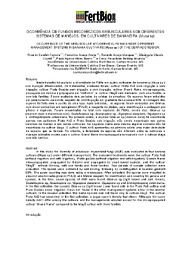Ocorrência de fungos micorrízicos arbusculares sob diferentes sistemas de manejos em cultivares de bananeira (Musa sp).
Ocorrência de fungos micorrízicos arbusculares sob diferentes sistemas de manejos em cultivares de bananeira (Musa sp).
Author(s): FERREIRA, R. S.; COSTA, F. A.; MARQUES, R. A.; CAMILI, E. C.; BUENO, P. A. A.; MIRANDA, C. H. B.
Summary: RESUMO - Neste trabalho foi avaliado a diversidade de FMAs em quatro cultivares de bananeira (Musa sp.) sob manejos diferenciados. Os tratamentos avaliados foram: cultivar Prata Anã sem irrigação e com irrigação, cultivar Prata Graúda sem irrigação e com irrigação, cultivar Grand Naine micropropagada, propagada por rizoma e propagada por “chifrinho”, e, cultivar Maçã sem desbaste, com uma família e com três famílias. Foram avaliados dois períodos de coletas de amostras. Os esporos foram extraídos por peneiramento via úmida, seguido de centrifugação em gradiente de sacarose 50%. A contagem dos esporos foi feita com o auxílio de uma lupa. Após extraídos, os esporos foram colocados em lâminas com álcool polivinílico em lactoglicerol (PVLG) e reagente de Melzer, para identificação e contagem por gênero e espécies. Foram encontradas no total sete espécies de FMAs, sendo elas: Glomus sp (marrom claro e marrom escuro), Scutellospora sp, Acaulospora sp, Gigaspora decipiens, Gigaspora sp e Entrosphospora colombiana. Na primeira coleta, a espécie Glomus sp (marrom claro) foi encontrada apenas nos cultivares Prata Anã e Prata Graúda sob irrigação, não sendo encontrada nos outros sistemas de manejo e nos outras cultivares. Na segunda coleta esta mesma espécie somente não foi encontrada no cultivar Maça. O cultivar Prata Anã apresentou na primeira coleta uma maior densidade de esporos que os demais. No entanto, a densidade de esporos não diferiram entre os cultivares e manejos adotados exceto para o cultivar Grand Naine micropropagada comparado com o cultivar Maça com três famílias. ABSTRACT - In this study the diversity of arbuscular mycorrhizal fungi (AMF) was evaluated in four banana cultivars (Musa sp.) under different management. The evaluated treatments were: the cultivar Prata Anã (without irrigation and with irrigation), Prata graúda (without irrigation and with irrigation), Grande Naine micropropagated, propagated by rhizome and propagated by small sword suckers, and, the cultivar “Maçã” without thinning, with one family and three families. Two periods of sample collection were evaluated. The spores were extracted by wet sieving, following by centrifugation in sucrose gradient 50%. The spore counting was done using a microscope. After extracted, the spores were mounted in polyvinyl alcohol-lacto-glicerol (PVLG) and Melzer reagent, for identification and counting for genera and species. In the total, seven species of AMF were found: Glomus sp (light brown and dark brown), Scutellospora sp, Acaulospora sp, Gigaspora decipiens, Gigaspora sp and Entrosphospora colombiana. In the first collection, the species Glomus sp (light brown ) was found only in the Prata Anã cultivar and Prata Graúda under irrigation, it was not found in the other management systems either in the another cultivars. In the second collection, this same species was not found only in cultivar Maçã. The cultivar Prata Anã had presented, in the first collection, a larger spore’s density that others. Although, the spore density didn’t differ among the cultivars and the managements adopted except for the micropropagated cultivar “Grand Naine” compared to the Maçã cultivar with three families.
Publication year: 2008
Types of publication: Paper in annals and proceedings
Unit: Embrapa Beef Cattle
Keywords: Banana Ana, Banana Maca, Banana Prata, Cultivars, Esporo, Fungo, Irrigation, Irrigação, Micropropagação, Mycorrhizal fungi, Variedade
Observation
Some of Embrapa's publications are published as ePub files. To read them, use or download one of the following free software options to your computer or mobile device. Android: Google Play Books; IOS: iBooks; Windows and Linux: Calibre.
Access other publications
Access the Agricultural Research Database (BDPA) to consult Embrapa's full library collection and records.
Visit Embrapa Bookstore to purchase books and other publications sold by Embrapa.

